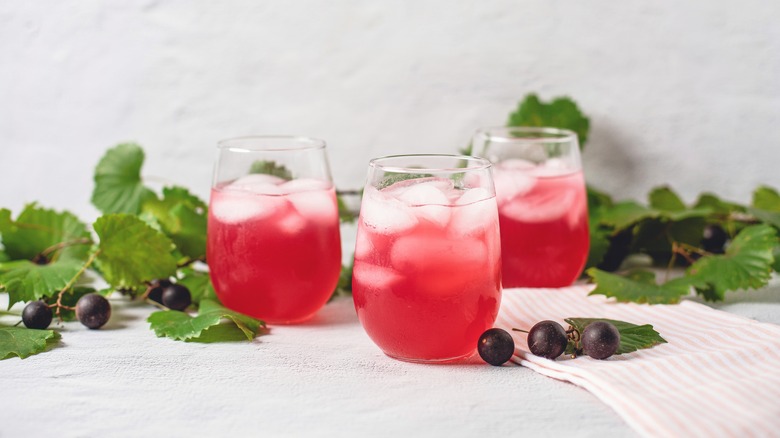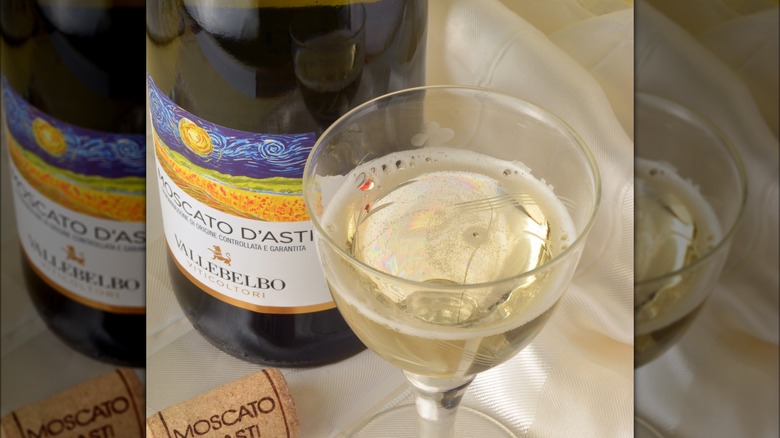What Makes Muscadine Wine Different From Moscato?
The wine world is full of similar-sounding names for wines — shiraz/syrah, grenache/garnacha, pinot gris/pinot grigio. Most often, this is a sign of the same grape going by different names in different parts of the world. So, it wouldn't be a surprise if most people assumed muscadine, a wine made in the southeastern United States, was somehow related to (if not the same as) moscato, the Italian wines made from muscat grapes. Although their names sound similar and each wine is often made in the same style — sweet and bubbly — moscato and muscadine differ in a number of ways, including their species, their origins, and even their popularity.
Moscato is probably the better known of the two types. Sales of moscato have been exploding in the United States since the early 2010s. Some attribute it to the demand among millennials for sweeter, lighter wines with low alcohol levels, while others refer to moscato's popularity among hip hop artists like Drake and Lil' Kim. Muscadine enjoyed that kind of popularity from the late 19th century to the early 20th century when it was the best-selling wine in the Southeast. Sales of the wine eventually surpassed the supply of its grapes. However, prohibition eventually put a cork in the industry and muscadine producers never regained the same sales or recognition, especially outside the region.
What is muscadine?
Muscadine wines are made from grapes of the same name grown throughout the Southeast, but primarily in North Carolina and Georgia, one of the most underrated wine regions in the U.S. Other states with notable muscadine production include Florida, Arkansas, South Carolina, and Mississippi. The grapes yield a variety of wines including white, red, and rose, as well as both sparkling and still types. They can be either dry or sweet, but are most often medium-bodied with medium acidity. The whites tend to have notes of banana, lime, and honeysuckle, while the reds feature more berry-like flavors.
Unlike most wine grapes, including moscato, which are from the European Vitis vinifera species, muscadine grapes are part of the Vitis rotundifolia grape species and are native to the United States. Many believe muscadine is the first wine grape cultivated in the U.S. and point to the fact that its 400-year-old "mother" vine is still producing fruit on North Carolina's Roanoke Island. Although there are more than 100 varieties of muscadine, the ones most commonly used for wine are Carlos and Scuppernong.
What is moscato?
Muscat grapes are grown throughout the world and have been cultivated for more than 800 years. Like muscadine, the grapes produce a variety of still, sparkling, sweet, and fortified wines. The most popular moscato wine is the one rappers started talking about it in their lyrics 15 to 20 years ago: moscato d'Asti. It's a semi-sparkling, sweet white wine from the northwestern Italian region of Piedmont. One of its most distinguishing characteristics is its low alcohol content of just 5%.
Another moscato that has enjoyed some popularity around the world is Asti Spumante, a bubblier, more Champagne-like wine with an alcohol content of about 9%. Both have floral, fruity notes, bringing to mind orange blossoms and peaches. Other than the sparkling styles of moscato D'Asti and Asti spumante, there are four other popular styles of moscato: still, a non-sparkling white; pink moscato, a rose blended with some merlot; red, produced from black muscat grapes; and even sweeter dessert wines.
Spicy meets sparkling and sweet
In sharing their sparkling and sweet styles, moscato and muscadine taste best with the same types of foods. Both muscadine and moscato wines pair well with spicy food, as the sugar and bubbles add a cool contrast to the heat. As a Southern grape, it's probably no surprise that muscadine makes a great match for smoky, hot barbecue ribs or brisket. But, you don't need to stick to American fare. Both types of wine also go great with spicy hot Asian cuisines, like Sichuan, Thai, or Vietnamese.
If you prefer to sip them alongside Italian food, try pairing the wines with a charcuterie platter. Both moscato and muscadine will offset the muskiness of a blue cheese, while cutting through the fattiness of meats like prosciutto, salami, and pancetta. And, even though nobody has been singing about muscadine lately, it might be a nice touch of Southern hospitality at your next dinner party.



